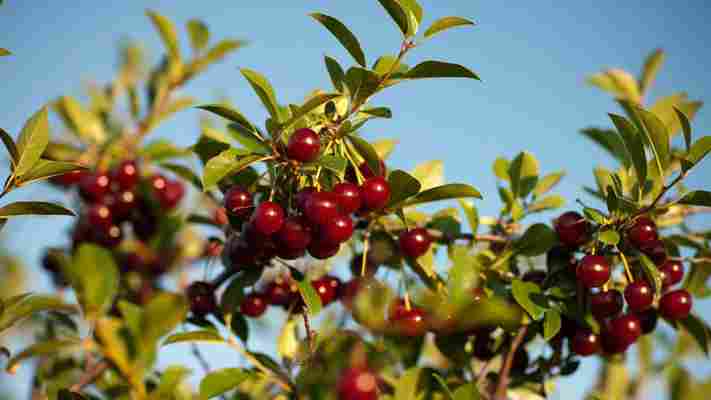Article continues below
My eyes drifted toward a mound of pastries on the counter of 33 1/3 Coffee Roasters , a cafe in downtown Regina, Saskatchewan, and my stomach growled with hunger. But a simple handwritten card piqued my interest, distracting me for a moment.
Placed directly in front of a large pile of bulbous-shaped scones, it read ‘Prairie Cherry’.
They grow them everywhere around here
As a first-time visitor to this western Canadian province, I didn’t know it was possible for this fruit, which traditionally thrives in temperate regions, to grow out on the prairies. During winter, temperatures can drop to as low as -40C, while drought-like conditions can persist for months during summer. Such extremes, I thought, would limit what farmers could harvest.
So somewhat meekly, I asked the barista, “What’s a prairie cherry?”
“It’s a variety of the fruit we’re known for in Saskatchewan,” he said, handing me my coffee. “They grow them everywhere around here.”

During winter, temperatures in Saskatchewan can drop to as low as -40C (Credit: Fotos by Gerry Marchand/Getty Images)
You may also be interested in: • The village that time almost forgot • Where to drink the world’s purest water • The oil that costs a small fortune
More than just a clever rhyme to lure hungry tourists, these dwarf sour cherries have been a culinary staple on the prairies for decades. Growing hardy and plentiful on short, stout bushes, their ornamental blooms and glossy leaves produce a deep-red fruit that is fully ripe from late July to early August. They’re tarter than traditional sweet cherries, and can be eaten straight from the tree.
One reason for their popularity can be attributed to the region’s immigrant communities who commonly incorporate them into their diets, according to Bob Bors, assistant professor and plant scientist at the University of Saskatchewan.
“The people who love it the most are the people who come from Eastern Europe and settled down here,” he explained. “They get totally thrilled that they have a sour cherry.”

Prairie cherries are tart and can be eaten straight from the tree (Credit: Greg Huszar Photography/Tourism Saskatchewan)
Bors leads the Fruit Programme for the university – one of the largest of its kind in North America – which has been breeding a variety of hardy, cold-weather plants for the last 90 years. As well as overseeing a dozen crops across 50 acres of property, the programme also includes a Prairie Fruit Genebank that preserves plants suited for prairie life. While their work focuses primarily on crops that can be commercialised, the university has also spent the last two decades marketing these tart and tangy fruits to the public to help distinguish them from other varieties.
“A lot of people don’t understand what a sour cherry is,” Bors said. “In my early years of promoting it here, I had to take our cherries physically around places before they would try growing them because they didn’t believe it was possible.”
That’s not the case anymore. In recent years, these cherries have become near ubiquitous on menus across the province due to their high sugar content, powerful antioxidants and durability. Unlike other varieties, these cherries maintain their intense flavour and colour even when cooked at high temperatures. Locals gloat over their medicinal properties, said to help treat things like inflammation. Regional chefs and bakers pop them in everything from cookies to pies to ice cream, while orchards and restaurants combine their juice into things like wine, beer and even whisky.

Prairie cherries are a popular ingredient in regional cuisine (Credit: Randy Risling/Getty Images)
Today, dwarf sour cherries may be grown in abundance by a wave of new commercial farmers, but it’s the storied history of how they came to be that has become a local legend.
Beginning in the late 1960s, professors and plant technicians at the university began growing dwarf-sized sour cherry plants from seedlings they’d collected from the Siberian Botanical Garden in Russia. When even these plants struggled to survive an entire Saskatchewan winter, the programme, led at the time by Dr Stewart Nelson, didn’t bother cross-breeding them with other hardy varieties, assuming they would never survive the extreme cold weather found in this part of the world.
“ Those cherries were crap except one tree,” said Rick Sawatzky, research technician for the university for the past 46 years, who worked with the early generations of these plants. “I made no headway.”
But that was all about to change. Unbeknown to most of the growers and farmers in the area, a local federal government employee named Dr Les Kerr had been working in private since the 1940s to improve the quality of sour cherries. As a lone grower, he was doing work no-one else thought could be done.
Saskatchewan’s cherries are the right size to be mechanically harvested, which is key to commercial fruit production (Credit: Bloomberg/Getty Images)
A lifelong horticulturist, Kerr had developed a keen interest early in life for breeding new fruits, especially those that needed improvements to outlast the cold weather. He experimented (with varying degrees of success) with a multitude of plants, such as crab apples, hazelnuts and peaches, and even dabbled in hybridizing dogs and coyotes, a project that didn’t go very far.
“He probably just did it out of curiosity,” Bors said. “Maybe that’s the key to his psyche. That he just did stuff just because he was curious.”
He probably just did it out of curiosity
It was his work breeding and crossing sour cherries that Kerr longed to perfect. Not only was the fruit the right size to be mechanically harvested – key to large-scale, commercial fruit production – but there was nothing else on the market like them. This financial viability was something Kerr understood from the beginning.
“I’m sure that was his goal right from the get-go,” Sawatzky said. “He was a very capable man.”
Even though Kerr’s initial attempts proved futile, he continued crossing his hardiest selections with other varieties, including some it’s believed he acquired from Siberia.
“His first crosses didn’t result in food quality that was all that great,” Sawatzky said. “But it made that very important first step.”
These cherries maintain their intense flavour and colour even when cooked at high temperatures (Credit: Greg Huszar Photography/Tourism Saskatchewan)
Over several generations, his plants improved to commercial quality. All the while, only a handful of his closest friends knew about his fruit-breeding projects; as a government employee who was mandated to grow shelterbelt trees, a type of shrub used for land borders and protection from wind and snowstorms, Kerr believed that if his superiors found out about his work they would put a stop to it immediately. So he kept his work secret from the public.
"He didn’t want to see it wasted,” Sawatzky explained. “He saw the value in it for the future."
But eventually Kerr had no choice but to share his success. In 1983, when he was nearing death, he invited several people to his hospital bedside to provide them with details of where they could find his work. Kerr had kept virtually no records, and only he knew where the several hundred plants were dispersed and hidden among two farms in the province.
“He may have had some in other places, but I was never made aware,” said Sawatzky, who helped locate the trees.
Before this discovery, the university had no longer been pursuing its own cherry breeding programme. But with Kerr’s bequeathal, along with an additional financial donation for research, the students were able to pick up where he left off.
The story of the prairie cherry inspired Dean Kreutzer, owner of Over the Hill Orchards (pictured), to learn to breed fruit (Credit: Greg Huszar Photography/Tourism Saskatchewan)
And it’s those plants that not only live to this day, but continue to inspire new growers, some of whom have built entire businesses around them.
“I do tours of the orchard, and I explain how it all started with Les Kerr,” said Dean Kreutzer, owner of Over the Hill Orchards in Lumsden, Saskatchewan.
Along with his wife Sylvia, Kreutzer opened the farming business in 1999 after retiring from his job as a computer programmer to pursue fruit breeding full time.
“I basically learned through trial and error how the actual trees worked and the different issues that horticulturists or orchard growers have to face,” he said. “I had absolutely no agricultural background at all.”
Queen Elizabeth II was served chocolate-covered prairie cherries when she visited Saskatchewan in 2005 (Credit: Chris Jackson/Getty Images)
Today, Over the Hill Orchards produces more than 50 different products, many of which are cherry flavoured, and hosts suppers on their 40 acres of property. They even had some luck feeding the Royal Family when Queen Elizabeth II and Prince Phillip visited the province for its 100th anniversary in 2005.
“When I heard that she was coming, I said, ‘She’s gotta eat something!’” Kreutzner exclaimed, explaining that he supplied 500 chocolate-covered cherries for the event.
Kerr’s the man with the vision. And the rest of us are just technicians just working on it
“It’s one of those things when you sit back and think, ‘I was a computer programmer and I just fed the Queen’. Quite a cool thing.”
And while the cherry industry continues to make strides improving the hardiness of these extraordinary plants, Kerr’s legacy will always remain strong.
"He had a vision that this could be carried. He’s the man with the vision. And the rest of us are just technicians just working on it," Sawatzky said.
Culinary Roots is a series from BBC Travel connecting to the rare and local foods woven into a place’s heritage.
Join more than three million BBC Travel fans by liking us on Facebook , or follow us on Twitter and Instagram .
If you liked this story, sign up for the weekly bbc.com features newsletter called "If You Only Read 6 Things This Week". A handpicked selection of stories from BBC Future, Earth, Culture, Capital and Travel, delivered to your inbox every Friday.
